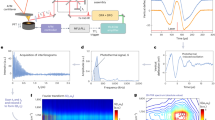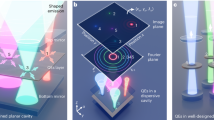Abstract
Terahertz (THz)-based electron acceleration has potential as a technology for next-generation cost-efficient compact electron sources. Although proof-of-principle demonstrations have proved the feasibility of many THz-driven accelerator components, THz-driven photoguns with sufficient brightness, energy and control for use in demanding ultrafast applications have yet to be achieved. Here we present a novel millimetre-scale multicell waveguide-based THz-driven photogun that exploits field enhancement to boost the electron energy, a movable cathode to achieve precise control over the accelerating phase as well as multiple cells for exquisite beam control. The short driving wavelength enables a peak acceleration gradient as high as ~3 GV m−1. Using microjoule-level single-cycle THz pulses, we demonstrate electron beams with up to ~14 keV electron energy, 1% energy spread and ~0.015 mm mrad transverse emittance. With a highly integrated rebunching cell, the bunch is further compressed by about ten times to 167 fs with ~10 fC charge. High-quality diffraction patterns of single-crystal silicon and projection microscopy images of the copper mesh are achieved. We are able to reveal the transient radial electric field developed from the charged particles on a copper mesh after photoexcitation with high spatio-temporal resolution, providing a potential scheme for plasma-based beam manipulation. Overall, these results represent a new record in energy, field gradient, beam quality and control for a THz-driven electron gun, enabling real applications in electron projection microscopy and diffraction. This is therefore a critical step and milestone in the development of all-optical THz-driven electron devices, validating the maturity of the technology and its use in precision applications.
This is a preview of subscription content, access via your institution
Access options
Access Nature and 54 other Nature Portfolio journals
Get Nature+, our best-value online-access subscription
$29.99 / 30 days
cancel any time
Subscribe to this journal
Receive 12 print issues and online access
$209.00 per year
only $17.42 per issue
Buy this article
- Purchase on Springer Link
- Instant access to full article PDF
Prices may be subject to local taxes which are calculated during checkout






Similar content being viewed by others
Data availability
The data that support the plots within this paper are available via figshare at https://doi.org/10.6084/m9.figshare.25391488 (ref. 50). All other data used in this study are available from the corresponding authors upon reasonable request. Source data are provided with this paper.
Code availability
The code used in this paper is available from the corresponding author upon reasonable request.
References
Ischenko, A. A., Weber, P. M. & Miller, R. J. D. Capturing chemistry in action with electrons: realization of atomically resolved reaction dynamics. Chem. Rev. 117, 11066–11124 (2017).
Gulde, M. et al. Ultrafast low-energy electron diffraction in transmission resolves polymer/graphene superstructure dynamics. Science 345, 200–204 (2014).
Filippetto, D. et al. Ultrafast electron diffraction: visualizing dynamic states of matter. Rev. Mod. Phys. 94, 045004 (2022).
Zewail, A. H. 4D ultrafast electron diffraction, crystallography, and microscopy. Annu. Rev. Phys. Chem. 57, 65–103 (2006).
Vogelsang, J., Hergert, G., Wang, D., Gross, P. & Lienau, C. Observing charge separation in nanoantennas via ultrafast point-projection electron microscopy. Light: Sci. Appl. https://doi.org/10.1038/s41377-018-0054-5 (2018).
Bressler, C. & Chergui, M. Ultrafast X-ray absorption spectroscopy. Chem. Rev. 104, 1781–1812 (2004).
Esarey, E., Schroeder, C. B. & Leemans, W. P. Physics of laser-driven plasma-based electron accelerators. Rev. Mod. Phys. 81, 1229–1285 (2009).
Malka, V. et al. Principles and applications of compact laser–plasma accelerators. Nat. Phys. 4, 447–453 (2008).
Wang, W. et al. Free-electron lasing at 27 nanometres based on a laser Wakefield accelerator. Nature 595, 516–520 (2021).
Shiloh, R. et al. Electron phase-space control in photonic chip-based particle acceleration. Nature 597, 498–502 (2021).
Sapra, N. V. et al. On-chip integrated laser-driven particle accelerator. Science 367, 79–83 (2020).
Zhang, D. et al. Segmented terahertz electron accelerator and manipulator (STEAM). Nat. Photonics 12, 336–342 (2018).
Zhang, D. et al. Cascaded multicycle terahertz-driven ultrafast electron acceleration and manipulation. Phys. Rev. 10, 011067 (2020).
Zhang, D. et al. Femtosecond phase control in high-field terahertz-driven ultrafast electron sources. Optica 6, 872–877 (2019).
Tang, H. et al. Stable and scalable multistage terahertz-driven particle accelerator. Phys. Rev. Lett. 127, 074801 (2021).
Hibberd, M. T. et al. Acceleration of relativistic beams using laser-generated terahertz pulses. Nat. Photonics 14, 755–759 (2020).
Curry, E., Fabbri, S., Maxson, J., Musumeci, P. & Gover, A. Meter-scale terahertz-driven acceleration of a relativistic beam. Phys. Rev. Lett. 120, 094801 (2018).
Kroh, T. et al. Compact terahertz-powered electron photo-gun. In Proc. 12th International Particle Accelerator Conference 2983–2985 (JACoW, 2021); https://doi.org/10.18429/JACoW-IPAC2021-WEPAB158
Zhang, D. et al. Long range terahertz driven electron acceleration using phase shifters. Appl. Phys. Rev. 9, 031407 (2022).
Hebling, J., Almasi, G., Kozma, I. & Kuhl, J. Velocity matching by pulse front tilting for large area THz-pulse generation. Opt. Express 10, 1161–1166 (2002).
Fülöp, J. A. et al. Efficient generation of THz pulses with 0.4 mJ energy. Opt. Express 22, 20155–20163 (2014).
Vicario, C., Monoszlai, B. & Hauri, C. P. GV/m single-cycle terahertz fields from a laser-driven large-size partitioned organic crystal. Phys. Rev. Lett. 112, 213901 (2014).
Zhang, B. et al. 1.4‐mJ high energy terahertz radiation from lithium niobates. Laser Photonics Rev. 15, 2000295 (2021).
Dal Forno, M. et al. Experimental measurements of rf breakdowns and deflecting gradients in mm-wave metallic accelerating structures. Phys. Rev. Accel. Beams 19, 051302 (2016).
Wu, X. et al. High-gradient breakdown studies of an X -band compact linear collider prototype structure. Phys. Rev. Accel. Beams 20, 052001 (2017).
Jolly, S. W. et al. Spectral phase control of interfering chirped pulses for high-energy narrowband terahertz generation. Nat. Commun. 10, 2591 (2019).
Zhang, D. et al. THz-enhanced DC ultrafast electron diffractometer. Ultrafast Sci. 2021, 1–7 (2021).
Snively, E. C. et al. Femtosecond compression dynamics and timing jitter suppression in a THz-driven electron bunch compressor. Phys. Rev. Lett. 124, 054801 (2020).
Zhao, L. et al. Femtosecond relativistic electron beam with reduced timing jitter from THz driven beam compression. Phys. Rev. Lett. 124, 054802 (2020).
Wimmer, L. et al. Terahertz control of nanotip photoemission. Nat. Phys. 10, 432–436 (2014).
Matte, D. et al. Extreme lightwave electron field emission from a nanotip. Phys. Rev. Res. 3, 013137 (2021).
Li, S. & Jones, R. R. High-energy electron emission from metallic nano-tips driven by intense single-cycle terahertz pulses. Nat. Commun. 7, 13405 (2016).
Fallahi, A., Fakhari, M., Yahaghi, A., Arrieta, M. & Kärtner, F. X. Short electron bunch generation using single-cycle ultrafast electron guns. Phys. Rev. Accel. Beams 19, 081302 (2016).
Ronny Huang, W. et al. Terahertz-driven, all-optical electron gun. Optica 3, 1209–1212 (2016).
Manz, S. et al. Mapping atomic motions with ultrabright electrons: towards fundamental limits in space-time resolution. Faraday Discuss. 177, 467–491 (2015).
Yang, J. et al. Imaging CF3I conical intersection and photodissociation dynamics with ultrafast electron diffraction. Science 361, 64–67 (2018).
Zou, Y., Cui, Y., Reiser, M. & O’Shea, P. G. Observation of the anomalous increase of the longitudinal energy spread in a space-charge-dominated electron beam. Phys. Rev. Lett. 94, 134801 (2005).
Lange, S. L., Noori, N. K., Kristensen, T. M. B., Steenberg, K. & Jepsen, P. U. Ultrafast THz-driven electron emission from metal metasurfaces. J. Appl. Phys. 128, 070901 (2020).
Hachmann, M. & Flöttmann, K. Measurement of ultra low transverse emittance at REGAE. Nucl. Instrum. Methods Phys. Res. A 829, 318–320 (2016).
Qi, F. et al. Breaking 50 femtosecond resolution barrier in MeV ultrafast electron diffraction with a double bend achromat compressor. Phys. Rev. Lett. 124, 134803 (2020).
Maxson, J. et al. Direct measurement of sub-10 fs relativistic electron beams with ultralow emittance. Phys. Rev. Lett. 118, 154802 (2017).
de Loos, M. J. et al. Compression of subrelativistic space-charge-dominated electron bunches for single-shot femtosecond electron diffraction. Phys. Rev. Lett. 105, 264801 (2010).
Kim, H. W. et al. Towards jitter-free ultrafast electron diffraction technology. Nat. Photonics 14, 245–249 (2020).
Zhao, L. et al. Terahertz streaking of few-femtosecond relativistic electron beams. Phys. Rev. 8, 021061 (2018).
Li, R. K. et al. Terahertz-based subfemtosecond metrology of relativistic electron beams. Phys. Rev. Accel. Beams 22, 012803 (2019).
Kealhofer, C. et al. All-optical control and metrology of electron pulses. Science 352, 429–433 (2016).
Müller, M., Paarmann, A. & Ernstorfer, R. Femtosecond electrons probing currents and atomic structure in nanomaterials. Nat. Commun. 5, 5292 (2014).
Huang, S.-W. et al. High conversion efficiency, high energy terahertz pulses by optical rectification in cryogenically cooled lithium niobate. Opt. Lett. 38, 796–798 (2013).
Computer Simulation Technology. https://www.cst.com
Ying, J. et al. Dataset for 'High gradient Terahertz-driven ultrafast photogun'. figshare https://doi.org/10.6084/m9.figshare.25391488 (2024).
Acknowledgements
The authors thank L. Qian for support with the laser system and helpful discussions regarding this work. D.Z. acknowledges support from the National Natural Science Foundation of China (grant no.12174255), the Science and Technology Commission of Shanghai Municipality (grant no. 22JC1401900), the Fundamental Research Funds for the Central Universities. F.X.K. acknowledges support from the European Research Council under the European Union’s Seventh Framework Programme (FP7/2007-2013) through the Synergy Grant AXSIS (609920), the Cluster of Excellence ‘Advanced Imaging of Matter’ of the Deutsche Forschungsgemeinschaft – EXC 2056 – project ID 390715994 and Project 655350 of the Deutsche Forschungsgemeinschaft and the accelerator on a chip programme funded by the Gordon and Betty Moore Foundation (GBMF4744). D.Z. also thanks the Yangyang Development Fund for sponsorship.
Author information
Authors and Affiliations
Contributions
F.X.K., D.Z. and N.H.M. conceived and coordinated the project. J.Y., X.H., D.S., L.Z. and D.Z. designed the experimental setup and carried out the experiments with the help of J.M. and P.Y. on the laser systems. T.K., T.R., M.F. and G.H.K. contributed with helpful discussion on the THz photogun design and experiments. All authors contributed to writing the article and reading and approving the final manuscript.
Corresponding authors
Ethics declarations
Competing interests
The authors declare no competing interests.
Peer review
Peer review information
Nature Photonics thanks the anonymous reviewers for their contribution to the peer review of this work.
Additional information
Publisher’s note Springer Nature remains neutral with regard to jurisdictional claims in published maps and institutional affiliations.
Supplementary information
Supplementary Information
Supplementary Figs. S1–S4 and Discussion.
Source data
Source Data Fig. 2
Statistical source data.
Source Data Fig. 3
Statistical source data.
Source Data Fig. 4
Statistical source data.
Source Data Fig. 5
Statistical source data.
Source Data Fig. 6
Statistical source data.
Rights and permissions
Springer Nature or its licensor (e.g. a society or other partner) holds exclusive rights to this article under a publishing agreement with the author(s) or other rightsholder(s); author self-archiving of the accepted manuscript version of this article is solely governed by the terms of such publishing agreement and applicable law.
About this article
Cite this article
Ying, J., He, X., Su, D. et al. High gradient terahertz-driven ultrafast photogun. Nat. Photon. (2024). https://doi.org/10.1038/s41566-024-01441-y
Received:
Accepted:
Published:
DOI: https://doi.org/10.1038/s41566-024-01441-y



